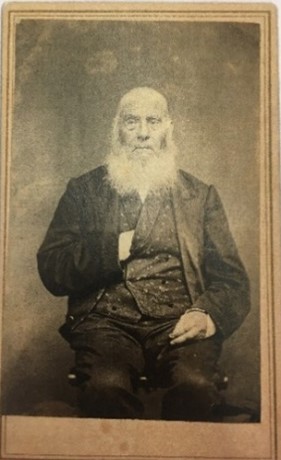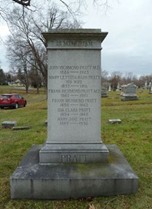

Charles Comstock Richards claimed that he and his father, Elder Franklin D. Richards “called upon Dr. J. R. Pratt who told my father that he could put his hand on the manuscript which Martin Harris lost, in an hour, if it was needed.”
John was born on March 2, 1826 in Manchester, New York. In his youth, he learned how to
tan calf skins and tan cow hides.[1] After the passing of his father, he inherited a house/tavern, 120 acres of farmland, and 600 books and dozens of manuscript. There are three scenarios as to what happened to the library of John Pratt—
The first scenario has the books and manuscripts remaining in the Pratt family until 1868. Then, the books became part of the collection of the public library in Shortsville, New York. Today, the only library in Shortsville is the Red Jacket Community Library. The library is located just minutes from Palmyra. The Red Jacket Community Library does not house old books or manuscripts. It has very limited information on local history.
The second scenario has the widow of John Richmond Pratt (Vivian Pratt) in 1964 giving the books and manuscripts to the Ontario Historical Society in Canandaigua, New York. We have copies of the loose manuscript pages donated to the society. None appear to be the lost 116 pages.
What is most curious—having an interest in the collection of books and papers that John Richmond Pratt’s widow gave to the Ontario Historical Society was former BYU professor, Wilford Poulson. Professor Poulson taught psychology in the 1940s at Brigham Young University. Poulson went back to Western New York after the Charles Comstock Richards lecture in 1947. The Wilford Poulson Papers are housed in the L. Tom Perry Special Collections at the Harold B. Lee Library. Hours have been spent going through his papers for clues about the 116 pages. Nothing was found.
The third scenario has Mary J. Pratt of Manchester giving the John Pratt Collection of books and manuscripts to the Manchester Library. Nothing of the collection was found in the Manchester Library.
On June 28, 1844, when Dr. J. R. Pratt was age eighteen his father paid his tuition and room and board for him to attend the Canandaigua Academy.[2] By November 1, 1844 he had received the following certificate to teach school: “This may certify that I have this day examined Mr. John R. Pratt and do believe him of good moral character and well qualified in respect to learning and ability to teach a common school in this town for the term of 1 year from this date.” It was signed by the superintendent of common schools for the town of Canandaigua (school #17)—Alonzo Beebe.
In 1851 at age twenty-five, John Richmond Pratt graduated from Jefferson Medical College in Philadelphia. He practiced his profession of allopathic medicine in Canandaigua for ten years. In 1852, like his father before him, John Richmond Pratt joined the masons, becoming one of the founders of the Canandaigua Lodge, F. & A. He served as the first junior warden and its second grand master in 1853. In 1854, he became a member of the Ontario County Medical Society.[3] By 1856, he had joined the Society of Honorary Members of the Canandaigua Philharmonic Society.[4]
By 1861, seven years before the death of his father, Dr. John Richmond Pratt moved into the family home/tavern on Main Street in Manchester. Although he set up his medical practice in town, he willingly left his practice to assist with the business affairs of his father. No sooner had he gotten his father’s affairs in order than at age thirty-seven, John was called to arms as a physician in the Union Army.[5]
When the war ended in 1865, Dr. J. R. Pratt put down roots in Decatur, New York. It was not until 1875 that he moved his family to Friendship, New York. And it was not until 1880, he again moved back to Manchester and set up a medical practice.
Dr. J. R. Pratt became a man-about-town. He knew the old timers and was personable enough to get acquainted with new residents. In 1892, when the town of Manchester was incorporated, he was elected the first president. He was elected every year after that until he refused to put his name on the ballot. Under his watch, a fire roared through the business district of Manchester, destroying mercantile businesses in its wake including the Pratt Brothers store, a dry goods and grocery store.[6] In spite of the loss, John did not have to carry any debt. He continued to be a popular local figure.
In 1910 at age eighty-four, he was still a practicing physician in Manchester. In 1911, he wrote, “Manchester History” in History of Ontario County, New York and Its People. Within the article is a section titled “Birth of Mormonism.” Although the article smacks of anti-Mormonism, it shows in his advanced age John was still interested in the roots of Mormonism in his neighborhood.
By 1920, life had dramatically changed for Dr. J. R. Pratt. He was age ninety-three, a widower, and retired. He had become hard of hearing. However, he had a retentive memory of town, county, and state history. On September 14, 1925, Dr. J. R. Pratt died at his home on Main Street in Manchester after a brief illness of less than twenty-four hours. He was ninety-nine years old. His funeral took place at his home.[7] Dr. J. R. Pratt was buried in the Brookside Cemetery at Shortsville, New York.
His obituary stated,
John was one of the oldest physicians and probably the oldest Mason in New York State to die. He died in Manchester at the very spot where he was born on March 2, 1826. He kept his faculties until the end, except he was hard of hearing. He is believed to be the oldest living person to remember Joseph Smith.
[1] John Pratt Collection, in Ontario County Historical Society. In author’s possession.
[2] John Pratt Collection.
[3] “Fiftieth Anniversary,” Democrat and Chronicle, October 11, 1904.
[4] John Pratt Collection.
[5] US Civil War Draft Registration Records, 1863–1865.
[6] John Pratt Collection.
[7] “Physician, Mason, 99, Dies,” Buffalo Courier, September 15, 1925.
